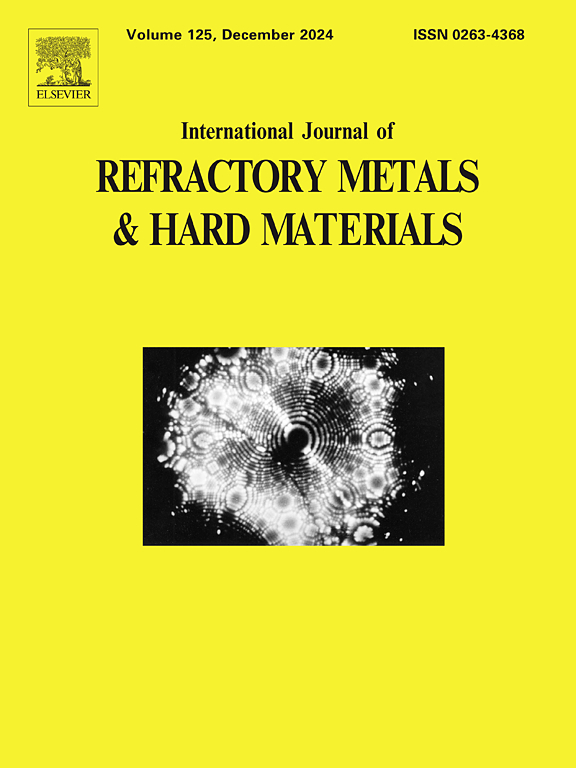Fabrication of high ductility TZM-La2O3 alloy and characterization of microstructure and mechanical properties
IF 4.6
2区 材料科学
Q2 MATERIALS SCIENCE, MULTIDISCIPLINARY
International Journal of Refractory Metals & Hard Materials
Pub Date : 2025-06-27
DOI:10.1016/j.ijrmhm.2025.107306
引用次数: 0
Abstract
This study employs spark plasma sintering (SPS) to fabricate TZM alloy doped with 0.5 wt% La2O3 at three different temperatures: 1800 °C, 1900 °C, and 2000 °C, and systematically investigates the effect of sintering temperature on its microstructure and mechanical properties. At 1900 °C, the alloy exhibits an equiaxed grain structure, achieving an optimal balance between grain size (7.03 ± 3.8 μm) and relative density (98.2 %). This temperature effectively suppresses excessive grain growth while promoting densification. The alloy attains a peak hardness of 211.3 HV0.2, an ultimate tensile strength (UTS) of 606 MPa, and an exceptional elongation (EL) of 24.3 %, representing a 148 % increase over the 1800 °C sintered sample (EL of 9.8 %) and an 18 % improvement over the 2000 °C sample (EL of 20.6 %). The corresponding product of strength and elongation (PSE) reaches 14.7 GPa·%, surpassing most previously reported TZM-based alloys in the literature. Fractographic analysis reveals that all samples exhibit ductile dimple fracture, though variations in the area proportion of dimpled regions lead to differences in EL. The 1900 °C sample displays the most favorable dimple morphology and highest ductility, attributed to its homogeneous microstructure and effective inhibition of grain boundary sliding by La2O3 particles. Results indicate that La2O3 nanoparticles strengthen the matrix through grain refinement and dislocation pinning, achieving an optimal combination of strength and ductility. Consequently, 1900 °C is identified as the ideal sintering temperature for the TZM-0.5 wt% La2O3 alloy.
高延展性TZM-La2O3合金的制备及其显微组织和力学性能表征
本研究采用火花等离子烧结(SPS)技术,在1800℃、1900℃和2000℃三种不同温度下制备掺杂0.5 wt% La2O3的TZM合金,系统研究了烧结温度对其显微组织和力学性能的影响。在1900℃时,合金呈现等轴晶粒结构,晶粒尺寸(7.03±3.8 μm)和相对密度(98.2%)达到最佳平衡。这个温度有效地抑制了晶粒的过度生长,同时促进了致密化。该合金的峰值硬度为211.3 HV0.2,极限抗拉强度(UTS)为606 MPa,延伸率(EL)为24.3%,比1800°C烧结样品(EL为9.8%)提高了148%,比2000°C烧结样品(EL为20.6%)提高了18%。相应的强度和伸长率(PSE)达到14.7 GPa·%,超过了文献中报道的大多数tzm基合金。断口分析表明,所有试样均表现为韧性韧窝断裂,但韧窝区域面积比例的不同导致了EL的差异。在1900°C时,由于其均匀的组织和La2O3颗粒对晶界滑动的有效抑制,样品表现出最有利的韧窝形态和最高的延展性。结果表明,La2O3纳米颗粒通过晶粒细化和位错钉住强化基体,实现了强度和塑性的最佳结合。因此,1900°C被确定为TZM-0.5 wt% La2O3合金的理想烧结温度。
本文章由计算机程序翻译,如有差异,请以英文原文为准。
求助全文
约1分钟内获得全文
求助全文
来源期刊
CiteScore
7.00
自引率
13.90%
发文量
236
审稿时长
35 days
期刊介绍:
The International Journal of Refractory Metals and Hard Materials (IJRMHM) publishes original research articles concerned with all aspects of refractory metals and hard materials. Refractory metals are defined as metals with melting points higher than 1800 °C. These are tungsten, molybdenum, chromium, tantalum, niobium, hafnium, and rhenium, as well as many compounds and alloys based thereupon. Hard materials that are included in the scope of this journal are defined as materials with hardness values higher than 1000 kg/mm2, primarily intended for applications as manufacturing tools or wear resistant components in mechanical systems. Thus they encompass carbides, nitrides and borides of metals, and related compounds. A special focus of this journal is put on the family of hardmetals, which is also known as cemented tungsten carbide, and cermets which are based on titanium carbide and carbonitrides with or without a metal binder. Ceramics and superhard materials including diamond and cubic boron nitride may also be accepted provided the subject material is presented as hard materials as defined above.

 求助内容:
求助内容: 应助结果提醒方式:
应助结果提醒方式:


